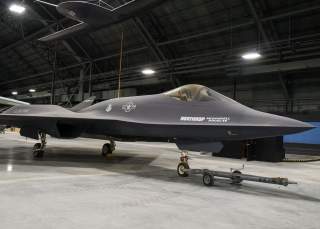F-22 and F-35 Would Never Have Happened (Had These Planes Been Picked Instead)
We break them down.
Had the YF-23 enjoyed a smoother development path (a huge “if”), the fighter might not have faced such a hostile environment as it entered service. But given that the YF-23 was generally perceived to be the more innovative (and therefore riskier) design, and that it had a slightly higher price tag, the chances that it could have sailed through without a hitch are correspondingly low. And trouble with design and production might have left the USAF with even fewer operational fighters.
Parting Thoughts:
The F-23 included some characteristics that may eventually find themselves in a sixth generation fighter, or perhaps in the Air Force’s “deep interceptor” intended to support B-21 Raiders on the way to their targets. For example, the V-tail aspect has been mentioned in some of the early conceptualization for a next generation fighter. And Boeing will undoubtedly hearken back to its experience with the F-23 when thinking about its next fighter.
For years, one of the two YF-23 prototypes sat in the Hangar of Unwanted Planes (more formally known as the Research and Development Hangar) at the National Museum of the United States Air Force in Dayton, Ohio. The YF-23 was positioned right under the last remaining XB-70 Valkyrie, the centerpiece of the museum’s collection. Both aircraft have now moved to the newly opened fourth building of the museum, where they continue to represent alternative visions of the (past) future of the Air Force, visions deeply grounded in the industrial and organizational realities of American airpower.
Robert Farley, a frequent contributor to TNI, is a Visiting Professor at the United States Army War College. The views expressed are those of the author and do not necessarily reflect the official policy or position of the Department of the Army, Department of Defense, or the U.S. Government.
Image: U.S. Department of Defense.

